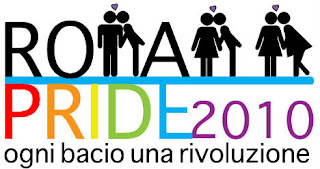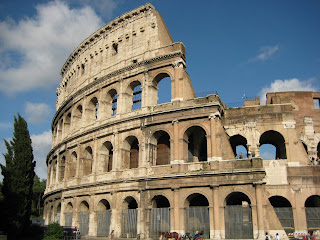Introduction
Like all things in society, gender roles are socially constructed, fluid, and susceptible to change. I am studying the women's movement in Italy and conducting research on the changing identity of Italian women. For many years women have been fighting for equal rights and opportunities all over the world. In the 1970's, feminist movements began in Italy but then began to fizzle out. However, that certainly was not the end of their struggle. In 2011, women's rights organizations are at an all-time high in Italy. I am interested in studying the path to women's revolution and exploring the cause behind the changing identity of Italian women. In this study I will discuss women's traditional gender roles versus modern gender roles, the declining birth rate, and women's rights organizations in Italy.
Methods
In order to find information on my research topic, I relied mostly on the internet and interviews with Italian women. Via the internet I could easily access databases full of current news articles relating to the changing image of women in Italy. I also used databases from JSTOR and the University of Washington libraries. I conducted interviews with three Italian women to whom I was introduced by my professors, Julie Villegas and Manka Varghese. My first interview was with Anna Galdo, a supervisor at Caritas. Caritas is a migrants’ counseling center in located in Rome that offers services to immigrants – job placement, language classes, housing programs, etc. My next interview was with Aurora Santoro, an Italian language professor who lives and works in Rome. Lastly, I interviewed Anita Joshi, an Italian woman who works for Internationale, a European magazine in Italy.
Literature Review/Findings
Traditional Roles vs. Modern Roles of Italian Women
Traditional roles of Italian women focus primarily on being a homemaker and a mother. According to an article from the BBC, “Traditional society in Italy was typically Mediterranean in the sense that Italian society was very patriarchal. Up until the 20th century, most women in Italy were not educated and were not expected to follow any vocation in life other than being a wife and rearing children (4).” Traditional values such as these are still held today by many Italians, especially those from older generations. Yet, in present day Italy it is difficult for men and women to maintain these traditional roles for several reasons, the most prominent being money and ever-changing societal values. Most young Italians want to work outside the home, attend college, and wait to get married or have children.
In an article titled “Italian Women Shun 'Mamma' Role” from BBC News, a woman is interviewed about the modern attitude of women in Italy. Laura Callura, the interviewee, states that “Many single women work hard to avoid the responsibilities of childcare. An increasing proportion of educated women no longer want to be just mothers and wives (5).” In fact, the college graduation rate for women in Italy has doubled over the last 20 years and just over the last decade the percentage of women in the workforce has gone from 22% to 47% (5). “Women's traditional role of wife and mother is no longer appealing, and young housewives perceive their situation more as a necessity than as a choice – working mothers declare themselves more satisfied than housewives and mothers” (5). Modern roles of women are different in the South than in the Northern part of Italy. Women in the South typically maintain more traditional roles because there are less job opportunities (5). All over Italy, however, one traditional roles that is still held for both men and women is living at home for a very long time. Laura Callura adds, "I lived with my parents until I was 29, most of my friends stayed with their parents until they were married (5).”
Low Birth Rates
Italy has one of the lowest birth rates in the Western world, according to BBC statistics. The Italian population is getting older and growing smaller by the day. With one in five Italians over age 65 and the fertility rate at 1.33 children per woman, it is estimated that by the year 2050, there will be 14 million less Italians (5). In the article “Social Viagra: Reproducing Boundaries, Social Cohesion, and Modernity in Italy” by Krause and Marchesi, the “demographic emergency” is discussed. There are several reasons behind the low birth rate in Italy. The increasing numbers of women attending university and joining the workforce is one reason but there are several more explanations, which are highlighted in Krause and Marchesi's article. Men not helping around the house with chores and childcare is another reason behind the low birth rate in Italy. However, the most prominent reason, according to Krause and Marchesi, is the inability to afford having a family (6).
Silvio Berlusconi
In a recent article from The Telegraph titled “Silvio Berlusconi Faces Nation's Women as a Million Protesters take to Streets” the scandal surrounding Silvio Berlusconi and the anger from Italian women is discussed. Silvio Berlusconi has been charged with having sex with a minor and abusing his privileges as a government official. The specific rally being highlighted in this article took place on 13 February 2011 and the aim of the rally was for women to protest how their dignity and the image of the country had been offended by the media tycoon’s obsession with young girls (7). At this particular rally women could be seen dressed as nuns and prostitutes waving banners saying “Berlusconi resign now” and “No prostitutes, no Madonnas, just women” (7). On this day in Italy over 200 cities nationwide voiced their disgust towards Berlusconi. The largest rallies were held in Milan, Genoa, Naples, Bari, and Rome. Rome, hosting the largest rally of all, hosted a gathering of thousands in Piazza del Popolo.
Women Fighting Back
The recent scandal involving Silvio Berlusconi has triggered a massive uproar from women's rights organizations all over Italy. “If Not Now, When?” is the largest women's rights organization in Italy and is a major leader in the fight for change. A recent article in The Guardian titled “Fighting Back Against Berlusconi” discusses an interview with Valeria Fedeli, one of the head coordinators of “If Not Now, When?”. Fedeli explains that “If Not Now, When?” is “A massive organization that protests against sexism and is designed to express the frustration of Italian women who are asking what it will take for Mr. Berlusconi to resign” (1). She goes on to explain that “The women proclaim 'If not now, when?' in regards to very sexualized and sexist (macho) environment of Italy, specifically, the attitude and activities of Berlusconi which is deemed to encourage underage prostitution. Berlusconi is also accused of abuse of power as he used his influence to get the girl in question out of police custody when she was detained (for theft). The organization “If Not Now, When?” is being discussed in the media as one of the most prominent movements at this time.
Discussion
In my opinion, the changing of traditional gender roles and the low birth rate in Italy makes sense for several reasons. First, increasing numbers of women are graduating college and becoming professionals than ever before. Therefore, if they are going to have a child, it will most likely be later in life after they have worked for several years, saved money, and are comfortable leaving their career. It is almost necessary for Italian women to leave their job after having a child because there is very little childcare available, private or public, and husbands commonly do not help out much at home. According to Aurora Santoro, an Italian professor in Rome, “Women are tired of putting up with men not working at home and leaving them to do all the chores and take care of the children, so, they have stopped getting themselves in that situation and work outside the home.” However, the most common reason for not having children in Italy is insufficient income and simply not being able to afford having a family. Once a couple has a child, there is only one source of income and many families cannot live on that alone. Also, it is often very difficult for a woman to return to work after having a child because of childcare options and because they become less attractive to employers. Employers fear that hiring a newly wed or a woman with a young child will affect her work and hours in the office. “Employers fear that newly weds will soon become mothers and that mothers will request too much time off to stay home caring for their child,” says Anna Galdo from Caritas.
One specific comment that came up numerous times up in each of my interviews is that women want to work. It is very hard for a woman to have children in Italy because, unlike other European countries, they get very little paid time off. The government is knowledgeable of this concern and the effect it is having on the birth rate in Italy. The government has started trying incentives to entice women to have children. In 2003, Roberto Marconi, the labor and welfare minister in Silvio Berlusconi's administration, began a trend of offering 1,000 euros to any woman who gave birth to a second child (8). This incentive worked relatively well and nearly 190,000 women in Italy decided to have a second child. Due to the success of the cash incentive, Maroni decided to offer women 1,000 euros for having one child. The success of the incentive was not long-lived, however, and birth rates continued, again, to decline. As a result, Marconi decided to offer women 10,000 euro over a 5 year period for each additional child they had (8). This effort from Marconi did not prove to be very successful, therefore, the government decided to go out and survey women to find out what incentives needed to be provided by the government in order to raise the birth rate in Italy. In an interview with Aurora Santoro, she mentioned that she had heard of the government conducting a survey of this type and she believes that many women would respond with demands of a system similar to that of so many other European countries – more paid time off and more government-paid childcare options available.
One aspect that I found particularity surprising was the lack of knowledge held by the average Italian man or woman who I spoke with on the street or in a cafe regarding this topic. In several interviews I conducted with local Italians, both men and women, when I asked about women in the workforce or the gender wage gap, or women's rights, most would not understand what I was talking about. Time and time again I would receive the same response, “of course women work, or course men and women are paid the same, women and men are treated the same.” This common response, I deduce, most likely has to do with the demographic of my interviewees – restaurant owners, sales clerks, musicians, and bartenders. There is in fact a gender wage gap in Italy but it is not common in every profession. According to a journal article by Bianca Beccalli, “Women working white-collar jobs are paid the same wage as their male counterparts but women working in manual labor are paid 1/3 less than men” (2). After several interviews with Italians I realized that the only way to get a strong response regarding the women's movement was to bring up Silvio Berlusconi.
I caught news of the Berlusconi scandal shortly after arriving in Rome. The case in question involves Nicole Minetti, Berlusconi's former dental hygienist and current member of his government. She is accused of “pimping” for Berlusconi and organizing "bunga-bunga" sex parties; and, of course, Ruby Rubacuori, the underage woman he allegedly paid for sex (1). Women are outraged by Berlusconi's behavior and deeply ashamed of how his actions are affecting Italy and the Italian people, especially Italian women. Several times during my time in Italy I was approached by women (on the bus, on the train, even on the street) explaining that Italians are embarrassed by Berlusconi, “Please do not think of him as the face of Italy.” Women are also ashamed that young Italian women are using their bodies to make a living from attracting Berlusconi's attention. Italian women want this to end immediately and are pushing for change as well as reaching out to young women to let them know that they can do more with their lives. Flavia Perina, editor of the Secolo d'Italia, stated in a recent article that “In the beginning, women were the hardcore Berlusconi voters, he was a seductive leader but now people understand that the gallantry was hollow. He has said too many things against women."
Lorella Zanardo, from CBC Radio, states that “For some Italian women, Prime Minister Silvio Berlusconi's sex scandal represents a tipping point. Time for women to rise up against a long standing culture of sexism...something that has been perpetuated by years of hyper-sexualized images on Italian television. And since Prime Minister Silvio Berlusconi owns three national television stations... some lay much of the blame on him” (9). This goes right along with a conversation I had with Anita Joshi: I asked her for her opinion regarding Berlusconi and his ownership of the main broadcasting systems and whether or not she felt advertising had been affected by his control? She responded by saying that “The media has been the same for many years, however, the recent scandals involving Berlusconi has changed the attention that is being given to the subject matter and has become an embarrassment to the country.”
As a result of Berlusconi's recent behavior, the men and women of Italy have begun to act. Marches and rallies have been taking place all over the country since the beginning of this year. As I previously discussed, Berlusconi has been treating women with disrespect and using the media to materialize females for many years, yet, until recently, little attention had been given to the issue. So why did it take women so long to act on this? Fedeli (“If Not Now, When?”) believes that “women have been anticipating for this movement for many years, they were just waiting for someone to lead them." According to an article in The Guardian, many Italians believe what is currently happening with the women's movement could turn into a cultural revolution in Italy.
Conclusion/Recommendations/Limitations/Benefits
I encountered several limitations while researching this topic. First, it was difficult to find recent scholarly articles about women in modern Italy. The majority of information I found was from the 1980's or early 1990's. This was difficult for me because the aim for my research is to discuss women and the women's movement in modern day Italy. In the future I plan to revisit this topic and hope to find scholarly research articles discussing the cultural revolution that is presently taking place in Italy. I would also like to find more information regarding sociological theories behind the changing identity of women in Italy.
On Tuesday, 8 March 2011, I attended a women's rally in Campo di Fiore. 8 March is women's day and the Campo was full of dancing women dressed in costumes and a truck playing loud music. I wish I would have been able to u understand what they were saying over their megaphone. My inability to speak Italian, I feel, limited my ability to truly understand everything there was to grasp about the women's movement. I wish I could have understood their passionate words of hope.
There are several benefits to researching this topic, as well. The biggest benefit I received from my research is that everything I have discussed here is currently taking place in Italy. I read several excellent articles with up-to-date information regarding the women's movement in Italy. Another unique benefit I received from doing this research is having been fortunate enough to be in Italy during this current time of women's action and being able to experience it firsthand.
I am a strong supporter of women's rights organizations and strongly feel that “If Not Now, When?” is making excellent progress towards changing the lives of women in Italy. It's an exciting time to be a woman in Italy. The women's movement in Italy has a lot of power behind it and I foresee a very positive future for Italian women.
Works Cited
1. Arie, Sophie. "Fighting Back against Berlusconi: Italian Women Take to the Streets." The Guardian. 18 Feb. 2011. Web. 16 Mar. 2011. <http://www.guardian.co.uk/lifeandstyle/2011/feb/18/fighting-back-against-berlusconi-italian-women>.
2. Beccalli, Bianca. "The Modern Women's Movement in Italy." New Left Review A.8 (1994). JSTOR. Web. 12 Mar. 2011.
3. Fantone, Laura. "Precarious Changes: Gender and Generational Politics in Contemporary Italy." Feminist Review 87.1 (2007): 5-20. JSTOR. Web. 19 Mar. 2011.
4. "Italian Women Hold Anti-Berlusconi Demonstrations." BBC News. 13 Feb. 2011. Web. 22 Mar. 2011. <http://www.bbc.co.uk/news/world-europe-12442833>.
5. "Italian Women Shun 'mamma' Role." BBC News. 27 Mar. 2006. Web. 16 Mar. 2011. <http://news.bbc.co.uk/2/hi/europe/4739154.stm>.
6. Krause, Elizabeth L., and Milena Marchesi. "Fertility Politics as "Social Viagra": Reproducing Boundaries, Social Cohesion, and Modernity in Italy." American Anthropologist 109.2 (2007): 350-62. JSTOR. Web. 16 Mar. 2011.
7. Pisa, Nick. "Silvio Berlusconi Faces Nation's Women as a Million Protesters Take to Streets - Telegraph." Telegraph.co.uk. 13 Feb. 2011. Web. 21 Mar. 2011. <http://www.telegraph.co.uk/news/worldnews/europe/italy/8321866/Silvio-Berlusconi-faces-nations-women-as-a-million-protesters-take-to-streets.html>.
8. Push Journal. "Italy’s Birth Rate Is The Second Lowest in the Western World." Doki.NET. 19 Apr. 2004. Web. 21 Mar. 2011. <http://www.doki.net/tarsasag/novedelem/upload/novedelem/document/birth_rate_in_Italy.htm>.
9. "Women's Rights in Italy." CBC.ca. 18 Feb. 2011. Web. 16 Mar. 2011.
<http://www.cbc.ca/thecurrent/news-promo/2011/02/18/womens-rights-in-italy/>.
Interviews
A. Galdo (communication via email, 4 March 2011)
A. Joshi (communication via email, 6 March 2011)
A. Santoro (personal communication, 3 March 2011)




